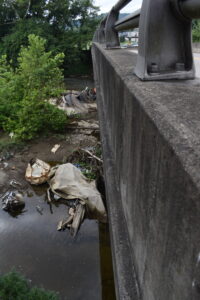Wheeling Officials: State Typically Handles Removing Flood Debris From Creeks

photo by: Eric Ayres
A large shipping container, unfurled sections of carpet, tool chests, tires and piles of other flood-related debris remain in Wheeling Creek near the Elm Grove area of Wheeling.
WHEELING — As recovery efforts continue after June’s deadly flooding in Ohio County, eyes are turning back to the creeks now that President Donald Trump officially issued a federal disaster declaration for impacted West Virginia counties.
Local officials indicated that a coordinated effort with state agencies in West Virginia should result in a plan to clear affected creek beds, which remain littered with debris.
Heavy rains on June 14 turned Little Wheeling Creek into a raging river, claiming the lives of nine people, destroying dozens of homes and leaving millions of dollars worth of damage and devastation in its path.
In the days that followed the floods, more than 75 mangled cars were pulled from the creek beds. Officials at that time stressed the importance of clearing vehicles, storage containers, trees and other large debris from the creeks for fear that the material could damage bridges and cause blockage in the event that the next hard rain could bring another bout of high water.
Rescue crews still searching for the missing back in June also wanted to pull vehicles from the creeks to make sure they were unoccupied, officials said.
Although pretty much all of the vehicles have since been removed from the creek beds, a month and a half after the disaster the creeks are still strewn with loads of flood debris through Elm Grove and downstream along Wheeling Creek.
The topic was raised by city leaders during the most recent meeting of Wheeling City Council one week before the long-awaited federal disaster declaration was issued.
“Who’s responsibility is this going to fall on to cleaning debris from the creek from the flood?” Wheeling City Councilman Ty Thorngate asked. “There are still multiple dumpsters, some shipping containers, car parts … scattered throughout from Elm Grove all the way to Kroger.”
Wheeling City Manager Robert Herron said that typically, state agencies have spearheaded the efforts to clear waterways following flood disasters, and they are subsequently reimbursed by the U.S. Federal Emergency Management Agency in cases where a federal disaster declaration has been issued.
“The estimated costs associated with doing that kind of work I know will be included in the FEMA application,” Herron noted.
Although much of the larger debris has already been removed, there are still significant amounts of personal property carried away during the flood and dumped downstream, where it sits to this day in piles of junk. At least one large shipping container that appears to be full of rolled carpets still sits in the middle of Wheeling Creek near the historic and recently restored Monument Place Bridge.
The container is slightly split open, and apparently some of the carpets were washed out of the container during the flood and unrolled. Large sections of carpet remain splayed open downstream under the Junior Avenue Bridget, caught in piles of other debris such as large tool chests, pressure washers, tires and truckloads of other junk.
Officials indicated that bridges were inspected following the floods because vehicles, shipping containers, dumpsters and other large items struck the supports during the flooding.
“It seems like there were a lot of those types of things that backed up underneath the bridges,” Wheeling City Councilman Ben Seidler said, noting that there were not many areas in the city where shipping containers had been sitting near the creeks. “Most of them I think came from outside the city limits.”
A number of business locations in the Triadelphia area – one of the hardest hit communities during the June 14 flood – had either salvaged vehicles or shipping containers stored within close proximity to Little Wheeling Creek when the high water struck.
“I think most, if not all, came from outside the city limits,” Herron noted. “There were a couple of dumpsters that rolled into the creek and hit the bridges.”
Following the flood, the city had to hire private contractors with heavy equipment to help pull the many vehicles out of the creeks in Elm Grove.
“The city picked all the cars out of the creek that were up against our bridges,” he said. “We wanted to make sure that if it were to happen, we didn’t want any damage to occur to the bridges because of all those cars or Conex boxes being there.”
FEMA offices have been established in Triadelphia and Valley Grove to help impacted residents file for assistance. Following federal disasters, the West Virginia Conservation Agency typically works with local, state and federal agencies for Emergency Watershed Protection to determine the extent of flood-related damages and to relieve debris and blockages from creeks and streams.
“It’s my understanding that the state of West Virginia will handle that,” Herron said, noting that city crews would not be able to retrieve the shipping containers that remain in the creek. “We’re not in a position to be able to go out and get those, but hopefully with this federal disaster declaration, the state will be able to handle that for us.”
The West Virginia Emergency Management Division, U.S. Small Business Administration, West Virginia Department of Natural Resources, West Virginia Department of Homeland Security, West Virginia Department of Health and Human Resources, West Virginia Department of Natural Resources, and other supporting agencies are expected to continue assisting with the disaster relief efforts in Ohio County.
City leaders are expected to meet with state officials in the near future to coordinate efforts to get the creeks cleared. Herron noted that all costs associated with flood-related recovery work are expected to be tallied and eventually submitted to FEMA for reimbursement in light of the disaster declaration.





